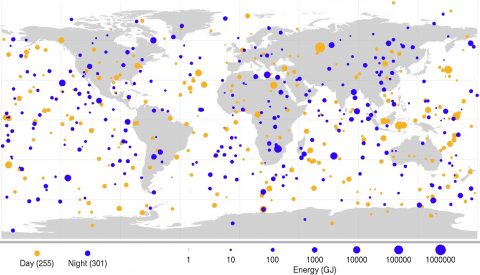
I was driving when it happened. It was dark out but the sky brightened over the course of a few seconds. I turned my head to look out the side window and saw the flashing streak in the sky.
My first thought was, “meteor,” but I didn’t know for certain because I didn’t hear the “boom” of the shockwave. I was in a car with the radio on, so I guess I just missed it. Sure enough, reports started coming in on social media that an asteroid had hit Earth around 8:10 p.m. local time on 16 January 2018, over the skies of southeast Michigan.
When an object from deep space encounters Earth’s atmosphere, it’s called a meteor. The meteor showers that occur regularly several times a year are when Earth flies through an old comet tail remnant, and the dust grains burn through our upper atmosphere. When a boulder from outer space hits our atmosphere, it makes it down a little lower, causing a brilliant light display and, at the end, an explosion. Instead of just being a meteor, we now call it a bolide. The small fragments that make it down to the surface are then called meteorites.
Bolide strikes occur dozens of times per year, as shown in the map below. They can happen pretty much anywhere on Earth at any time of day.
 Bolide events from 1994 to 2013. Credit: NASA/Planetary Science
Bolide events from 1994 to 2013. Credit: NASA/Planetary Science
These space rocks, really tiny asteroids, range from a basketball to a building in size. They enter the atmosphere at thousands of miles per hour, well above the speed of sound. The friction caused by the moving the air out of the way strips off the front the object, weakening it, and eventually resulting in catastrophic failure – the explosion. The sonic boom from this fast-moving object sometimes reaches the ground shaking buildings and perhaps breaking windows, like an earthquake.
The one that hit Michigan was probably the size of an exercise ball. It wasn’t a big enough sonic boom to break windows, but they estimate the shaking was equivalent to a 2.0 magnitude earthquake. After it exploded, there could have been fragments that did not disintegrate, which would have fallen to the ground. So, somewhere north of Detroit, there could a meteorite debris field scattered in the snow.
The bigger bolides can be dangerous. The one that blew up over Siberia in February 2013 had a strong enough sonic boom that roughly a thousand people in Chelyabinsk, Russia, went to the hospital, mostly from cuts due to flying glass but also broken bones from falling objects. No one died and the meteorite debris landed in a field outside of town. That one they estimated at about 10 tons, which is a rock roughly 5 to 6 feet in diameter.
Another bolide that blew up over Siberia in 1908 was gigantic. The estimate for the size Tunguska meteor is a couple hundred meters across – picture a rock that fills a sports stadium. It obliterated several hundred square miles of forest land. If the one over Michigan had been that big, I probably would not be here to write this!
We didn’t know the Michigan bolide was coming because asteroids that small are very hard to see. NASA has telescopes looking for near-Earth objects and big asteroids heading towards our planet, but these smaller ones are too hard to see; we have to be very lucky to spot it before it reaches Earth. So, usually, we have no warning before a bolide strike.
If it’s a larger object, then hopefully we see it early enough to deflect it out of the path of Earth. NASA has plans for this type of operation, including laser blasting the object or hitting it with a missile. Luckily, we haven’t had to exercise those plans yet!
As you can see from the NASA map, bolides release many GigaJoules of energy into the atmosphere. This occurs over just a few seconds; for the Michigan bolide that I witnessed, it was less than 5 seconds of continual brightening and then a flash of light at the end. Dr. Brown’s Delorean, from the Back to the Future movies, could easily make it to 1955, and back, from one of these bolides strikes, because it is often much more than 1.21 GigaWatts of power. The only trick is to predict when it will happen – sounds like a sequel to me!
—Mike Liemohn, Editor-in-Chief of JGR: Space Physics, and Department of Climate and Space Sciences and Engineering, University of Michigan; email: liemohn@umich.edu
Editor’s Note: See Mike Liemohn talking further about bolides here.
Correction, 19 January 2018: In an earlier version of this article, two numbers were transposed in the amount of power required for time travel in the Back to the Future movies. This has been corrected.
from Eos https://eos.org/editors-vox/airborne-fireball?utm_source=rss&utm_medium=rss&utm_content=airborne-fireball
via IFTTT
